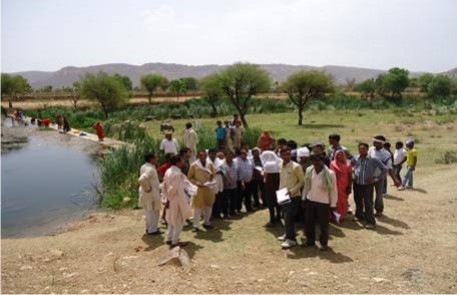Participatory Planning and
Sustainable Development:
Role of the Watershed Committees
Background
M
ore than 200 million of the rural poor in India live in rain-fed agricultural areas. A large proportion of them live in chronic poverty. Farmers in semi-arid regions of India face a number of bio-physical and socio-economic constraints which negatively impact crop and livestock productivity. Depletion of natural resources, low productivity, low levels of technology, inadequate financial services and poor market linkages have badly affected the livelihoods of farmers in these regions.
The Integrated Watershed Management Programme (IWMP) has become a cornerstone of the rural development policy in many of the rain-fed regions of the country. Development Alternatives (DA) has been selected as the Programme Implementing Agency (PIA) for one such programme run by the Madhya Pradesh government, the "Rajiv Gandhi Mission for Watershed Management" (RGMWM). DA currently manages 1000 ha of land each in Datia and Tikamgarh districts under the scheme of IWMP. The twin goals of the programme are poverty reduction and environmental regeneration.
Participatory model of watershed management:
The RGMWM operates in a participatory mode. It is run through a tri-level structure of management involving a wide cross-section of stakeholders hailing from government organisations, NGOs and civil society. It emphasises participation of watershed users in planning, decision making and implementation of the programme. Participatory rural appraisals (PRA) are used throughout the stages of planning and selection of watersheds. Awareness and training sessions and programmes on literacy, family welfare, social services, income generating activities etc. are also undertaken in the villages. Small contributions to SHGs or other village institutions like Mahila Mandals/ youth clubs/ anganwadis/ federations are permitted.
The Watershed Committee looks after the development of various village level institutions such as Self Help Groups (SHGs) and User Groups (UGs) ensuring that a participatory model is adhered to. It comprises at least 10 members including panchayat members, pradhans/ward members and the Village Development Committee. Half of the members are representatives of SHGs and User Groups, members of the SC/ST community, women and landless persons in the village. One member of the Watershed Development Team (WDT) shall also be a member of the WC. The Gram Sabha creates the WC and entrusts it with the task of implementing the Watershed project with the technical help and support of the WDT. It has to get registered under the Society Registration Act, 1860, and has to open a separate bank account for receiving funds for the approved watershed projects and other related activities.
The WC ensures participatory implementation of the watershed programme. The Committee identifies the requirements of a given area and finalises the activities to be undertaken in a participatory mode based on the village level assessment. The members are responsible for coordination and liaison with the Gram Panchayat, the WDT and all other government agencies to ensure smooth implementation of the project. The Watershed Committee carries out day-to-day activities and implements decisions taken by all the elected bodies. It facilitates agreements pertaining to the use of resources by various User Groups as a pre-condition for any activity. This collective decision making promotes environment regeneration and poverty alleviation in an equitable manner.
Over much of India’s history, water has been managed very successfully as a local resource. Unfortunately, the logic of the so-called ‘economies of scale’ has led to a quest for larger projects and more centralised management systems resulting in many cases in an inequitable distribution of the resource. On the other hand, Watershed Committees created by villagers have succeeded to a great extent in ensuring sustainability of the participatory programmes. q
Dr. Krishna Murari